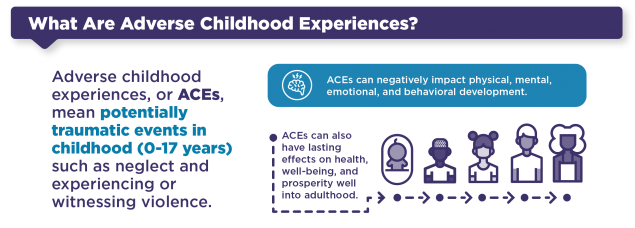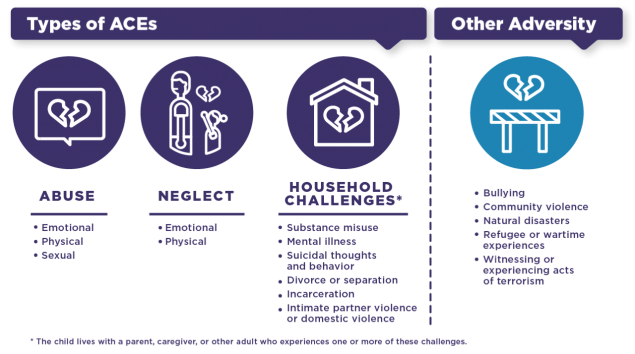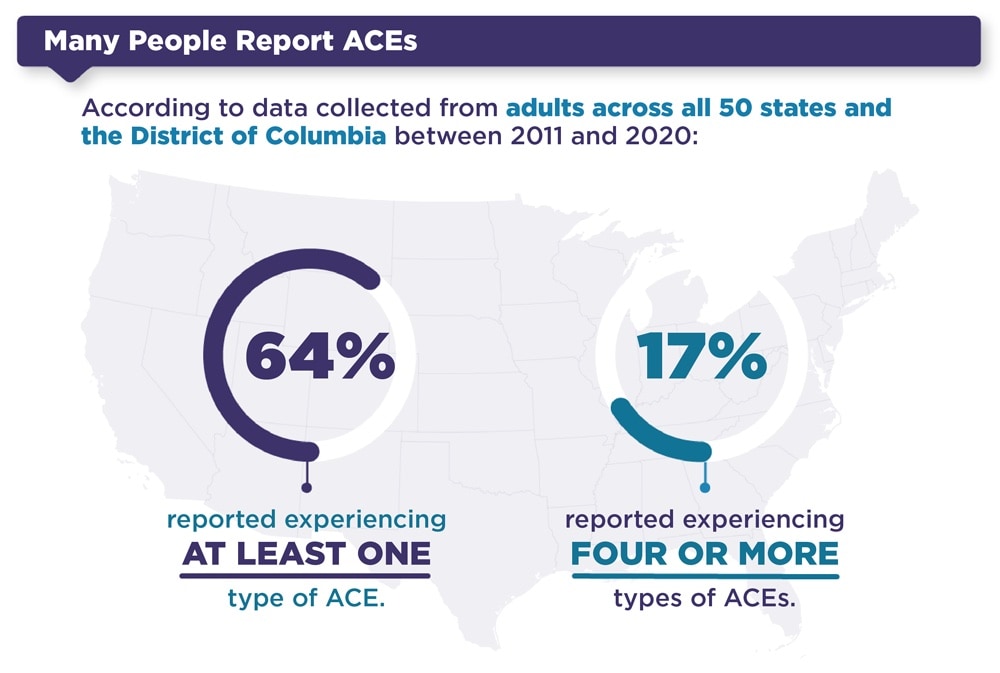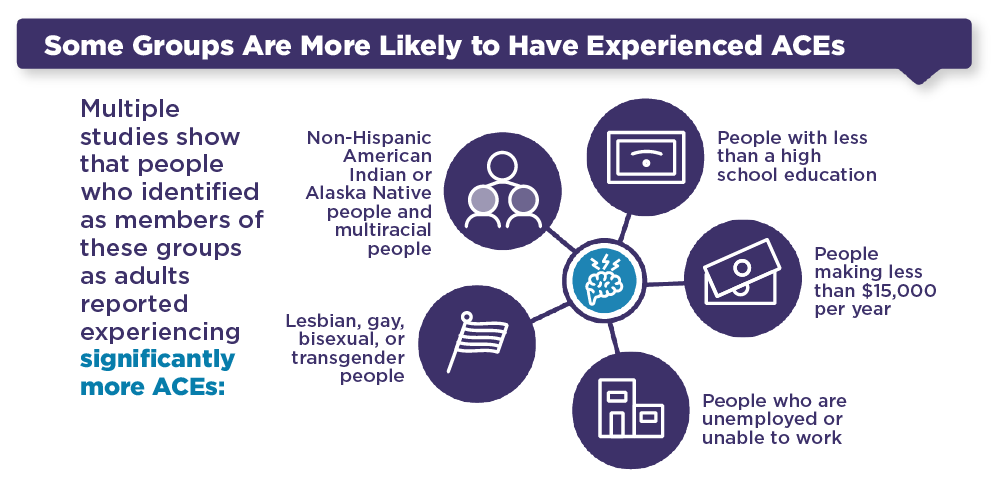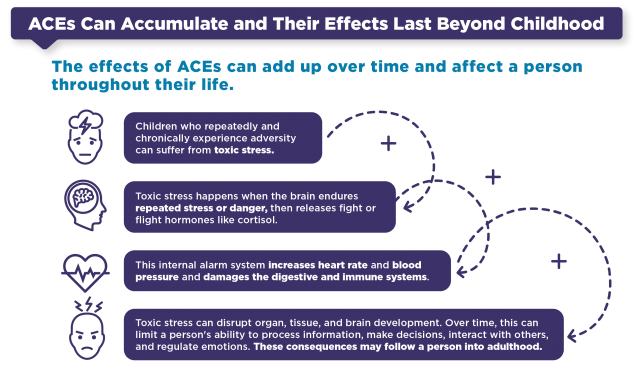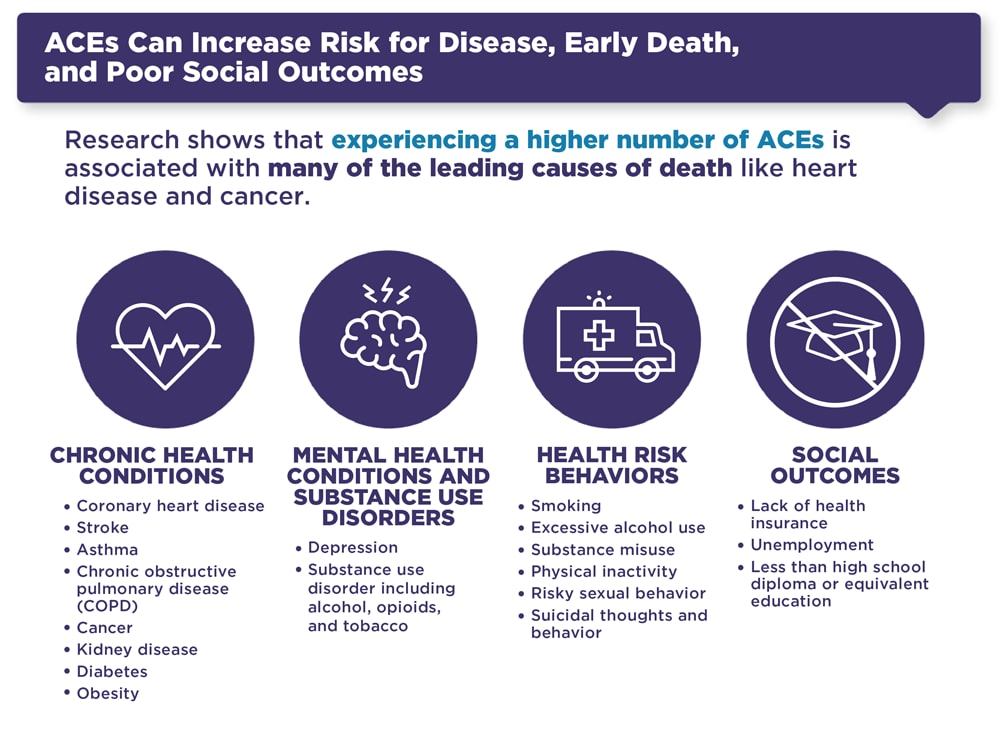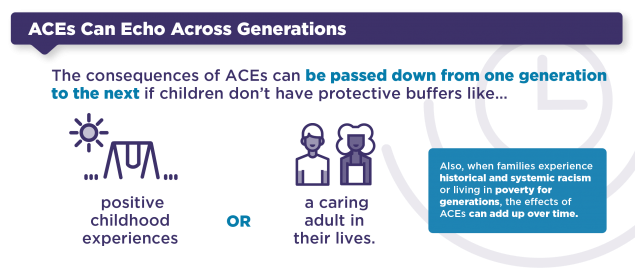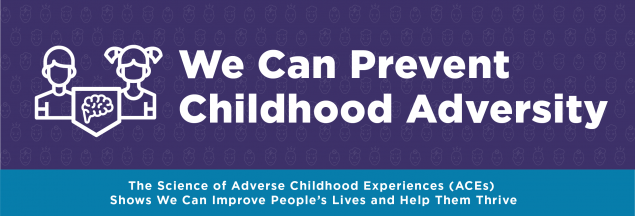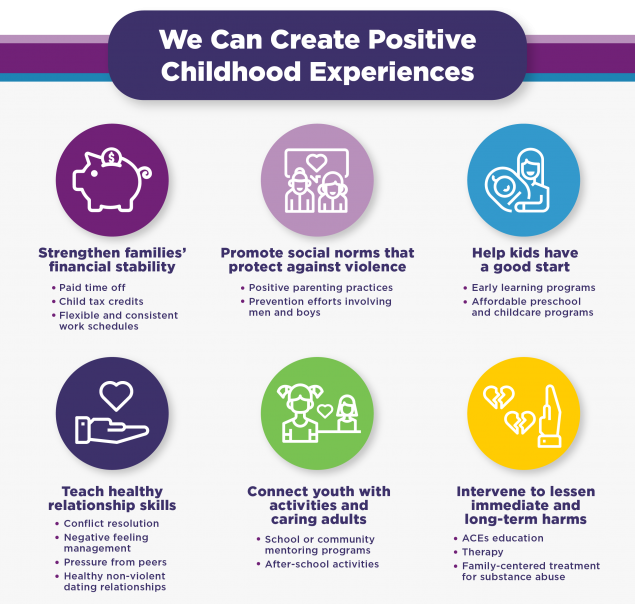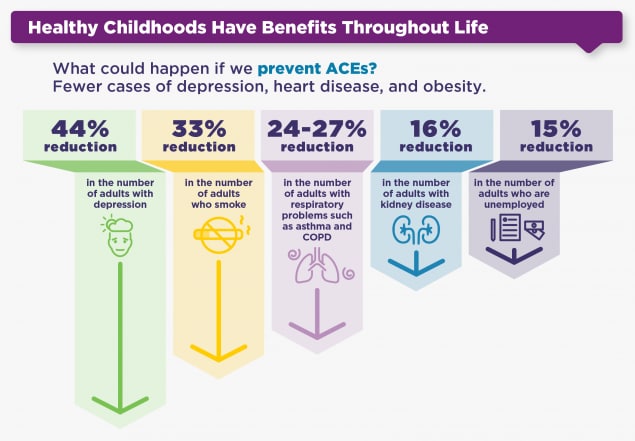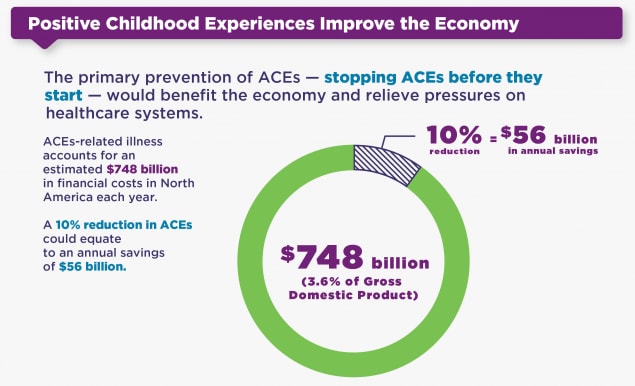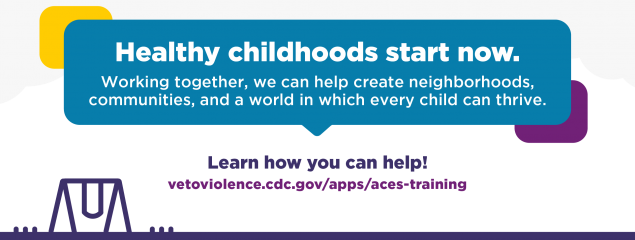Adverse Childhood Experiences Resources
Publications
Fact Sheet:
- Vital Signs Fact Sheet: Adverse Childhood Experiences (ACEs) [865 KB, 2 Pages, 508]
CDC’s Vital Signs fact sheet featuring ACEs and their negative impacts on health as well as education and employment opportunities later in life.
CDC Reports:
- Adverse Childhood Experiences (ACEs) Prevention Strategy Plan [3 MB, 20 Pages]
This resource outlines CDC’s specific goals and objectives for ACEs prevention and response. The goals and objectives aim to prevent ACEs before they happen, identify those who have experienced ACEs, and respond using trauma-informed approaches in order to create the conditions for strong, thriving families and communities where all children and youth are free from harm and all people can achieve lifelong health and wellbeing. - Adverse Childhood Experiences Prevention Resource for Action [4 MB, 38 Pages]
This is a resource to help states and communities leverage the best available evidence to prevent ACEs from happening in the first place as well as lessen harms when ACEs do occur. It features six strategies drawn from the CDC Resources for Action, formerly known as, “technical packages.” - Child Abuse and Neglect Prevention Resource for Action [4 MB, 50 Pages]
CDC’s Resource for Action, formerly known as, “technical package,” identifies a number of strategies based on the best available evidence to help states and communities prevent and reduce child abuse and neglect. Also available in Spanish [21 MB, 52 Pages, 508] - Guidance for Analyzing 2021 Adverse Childhood Experiences and Positive Childhood Experiences Data [738 KB, 30 Pages]
This resource provides guidance to help state and local agencies analyze Adverse Childhood Experiences (ACEs) and Positive Childhood Experiences (PCEs) data gathered on the 2021 Youth Risk Behavior Survey (YRBS).
Case Studies:
The state case studies provide detailed descriptions of how selected states have valued and used ACE data to inform their child abuse and neglect prevention efforts.
- Learning from Alaska’s Adverse Childhood Experiences (ACE) Story [208 KB, 3 Pages, 508]
Outlines Alaska’s journey to raise awareness of ACEs, collect state-level ACE data, and efforts to use ACE data to inform prevention of child abuse and neglect. - Learning from Oklahoma’s Adverse Childhood Experiences (ACE) Story [264 KB, 2 Pages, 508]
Highlights Oklahoma’s efforts to use their ACE data to inform their state’s prevention actions, as well as next steps in preventing child abuse and neglect. - Learning from Washington’s Adverse Childhood Experiences (ACE) Story [233 KB, 2 Pages, 508]
Highlights how Washington supported state-level ACE data collection, how data were used to inform prevention efforts, and provides examples of the state’s next steps in preventing abuse and neglect. - Learning from Wisconsin’s Adverse Childhood Experiences (ACE) Story [221 KB, 2 Pages, 508]
Describes how Wisconsin utilized their ACE data to provide a platform to increase support for evidence-based strategies that promote protective factors.
Morbidity and Mortality Weekly Reports (MMWRs):
- Swedo EA, Aslam MV, Dahlberg LL, et al. Prevalence of Adverse Childhood Experiences Among U.S. Adults — Behavioral Risk Factor Surveillance System, 2011–2020. MMWR Morb Mortal Wkly Rep 2023;72:707–715. DOI: http://dx.doi.org/10.15585/mmwr.mm7226a2.
- Anderson KN, Swedo EA, Trinh E, et al. Adverse childhood experiences during the COVID-19 pandemic and associations with poor mental health and suicidal behaviors among high school students – -Adolescent Behaviors and Experiences Survey, United States, January – June 2021. MMWR Morb Mortal Wkly Rep 2022;71:1301-1305. DOI: 10.15585/mmwr/mm7141a2
- Merrick MT, Ford DC, Ports KA, et al. Vital Signs: Estimated Proportion of Adult Health Problems Attributable to Adverse Childhood Experiences and Implications for Prevention — 25 States, 2015–2017. MMWR Morb Mortal Wkly Rep 2019; 68:999-1005.
ACEs Questionnaires:
The questionnaires are not copyrighted, and there are no fees for their use. If you include the ACE Study questionnaires in your research, a copy of the subsequent article(s) is requested (send to dvpinquiries@cdc.gov).
The Family Health History and Health Appraisal questionnaires were used to collect information on child abuse and neglect, household challenges, and other socio-behavioral factors in the original CDC-Kaiser ACE Study.
- Family Health History Questionnaire
- Health Appraisal Questionnaire
The BRFSS ACE module was adapted from the original CDC-Kaiser ACE Study and is used to collect information on child abuse and neglect and household challenges. Please see the BRFSS Questionnaires website for the most up-to-date versions of the BRFSS ACE Modules.
Journal Articles by Topic Area
Commentary:
- Jones CM, Merrick MT, Houry DE. Identifying and Preventing Adverse Childhood Experiences: Implications for Clinical Practice. JAMA. 2020;323(1):25–26. doi:10.1001/jama.2019.18499
- Merrick MT, Guinn AS. (2018). Child Abuse and Neglect: Breaking the intergenerational. American Journal of Public Health, 108(9), pp.1117–1118.
- Ports KA, Merrick MT, Stone DM, Wilkins NJ, Reed J, Ebin J, & Ford DC. (2017). Adverse Childhood Experiences and Suicide Risk: Toward Comprehensive Prevention.Am J Prev Med 53(3), 400-403
- Metzler M, Merrick MT, Klevens J, Ports KA, Ford DC. Adverse childhood experiences and life opportunities: shifting the narrative. Children and Youth Services Review. 2017 Jan 1;72:141-9.
- Anda RF, Butchart A, Felitti VJ, Brown DW. Building a framework for global surveillance of the public health implications of adverse childhood experiences. Am J Prev Med. 2010 Jul;39(1):93-8.
- Foege WH. Adverse childhood experiences: A public health perspective. Am J Prev Med. 1998;14:354–355.
Overview:
- Anderson KN, Swedo EA, Clayton HB, Holditch Niolon P, Shelby D, McDavid Harris K. Building infrastructure for surveillance of adverse and positive childhood experiences: integrated, multi-method approaches to generate data for prevention action. Am J Prev Med 2022;62(6S1):S31-S39. doi: 10.1016/j.amepre.2021.11.017
- Asmundson GJ, Afifi TO. Adverse childhood experiences: Using evidence to advance research, practice, policy, and prevention. Academic Press; 2019 Oct 3.
- Merrick MT, Ford DC, Ports KA, Guinn AS. (2018). Prevalence of Adverse Childhood Experiences From the 2011-2014 Behavioral Risk Factor Surveillance System in 23 States. JAMA Pediatrics, 172(11), 1038-1044.
- Gilbert LK, Breiding MJ, Merrick MT, Parks SE, Thompson WW, Dhingra SS, Ford DC. Childhood adversity and adult chronic disease: An update from ten states and the District of Columbia, 2010.Am J Prev Med. 2015;48(3):345-9.
- Felitti V. Adverse childhood experiences and adult health [145.14 KB, 3 Pages, Print Only]. Acad Pediatr. 2009;9:131-132.
- Edwards VJ, Anda RF, Dube SR, Dong M, Chapman DF, Felitti VJ. The wide-ranging health consequences of adverse childhood experiences. In Kathleen Kendall-Tackett and Sarah Giacomoni (eds.) Victimization of Children and Youth: Patterns of Abuse, Response Strategies, Kingston, NJ: Civic Research Institute; 2005.
- Felitti VJ, Anda RF, Nordenberg D, Williamson DF, Spitz AM, Edwards V, Koss MP, Marks JS. Relationship of childhood abuse and household dysfunction to many of the leading causes of death in adults: the adverse childhood experiences (ACE) study.Am J Prev Med. 1998;14:245–258.
Chronic Disease:
Autoimmune Disease
- Dube SR, Fairweather D, Pearson WS, Felitti VJ, Anda RF, Croft JB. Cumulative childhood stress and autoimmune disease. Psychom Med.2009;71:243–250.
Cancer
- Ports KA, Holman DM, Guinn A, Pampati S, Dyer K, Merrick MT, Buchanan N, & Metzler M. (2019). Association between Adverse Childhood Experiences and Leading Risk Factors for Cancer in Adulthood. Journal of Pediatric Nursing, 44, 81-96.
- Holman DM, Ports KA, Buchanan N, Hawkins N, Merrick MT, & Trivers K. (2016). The Association between Adverse Childhood Experiences and Risk for Cancer in Adulthood: A Systematic Review of the Literature. Pediatrics, S81-S91.
- Brown MJ, Thacker LR, Cohen SA. Association between adverse childhood experiences and diagnosis of cancer. PLoS One. 2013 June;8(6):e65524.
- Brown DW, Anda RF, Felitti VJ, Edwards VJ, Malarcher AM, Croft JB, Giles WH. Adverse childhood experiences and the risk of lung cancer. BMC Public Health. 2010;10:20.
Chronic Obstructive Pulmonary Disease
- Cunningham TJ, Ford ES, Croft JB, Merrick MT, Rolle IV, Giles WH. Sex-specific relationships between adverse childhood experiences and chronic obstructive pulmonary disease in five states. International Journal of Chronic Obstructive Pulmonary Disease.2014;9:1033-42.
- Anda RF, Brown DW, Dube SR, Bremner JD, Felitti VJ, Giles WH. Adverse childhood experiences and chronic obstructive pulmonary disease in adults. Am J Prev Med.2008;34(5):396-403.
Disability
- Campbell JA, Walker RJ, Egede LE. Associations between adverse childhood experiences, high-risk behaviors, and morbidity in adulthood. American Journal of Preventive Medicine. 2016 Mar 1;50(3):344-52.
- Rose SM, Xie D, Stineman M. Adverse childhood experiences and disability in US adults. PM&R. 2014 Aug 1;6(8):670-80.
Health-Related Quality of Life
- Barile JP, Edwards VJ, Dhingra SS, Thompson WW. Associations among county-level social determinants of health, child maltreatment, and emotional support on health-related quality of life in adulthood. Psychol Violence. 2014 Oct.
- Corso PS, Edwards VJ, Fang X, Mercy JA. Health-related quality of life among adults who experienced maltreatment during childhood. Am J Public Health.2008;98:1094–1100.
Ischemic Heart Disease
- Dong M, Giles WH, Felitti VJ, Dube, SR, Williams JE, Chapman DP, Anda RF. Insights into causal pathways for ischemic heart disease: adverse childhood experiences study. Circulation. 2004;110:1761–1766.
Liver Disease
- Dong M, Anda RF, Dube SR, Felitti VJ, Giles WH. Adverse childhood experiences and self-reported liver disease: new insights into a causal pathway. Arch Intern Med. 2003;163:1949–1956.
Obesity
- Schroeder K, Schuler BR, Kobulsky JM, Sarwer DB. The association between adverse childhood experiences and childhood obesity: A systematic review. Obesity Reviews. 2021 Jul;22(7):e13204.
- Williamson DF, Thompson, TJ, Anda, RF, Dietz WH, Felitti VJ. Body weight, obesity, and self-reported abuse in childhood.International Journal of Obesity. 2002;26:1075–1082.
Sexual Risk Behavior
- Hillis SD, Anda RF, Felitti VJ, Marchbanks PA. Adverse childhood experiences and sexual risk behaviors in women: a retrospective cohort study.Fam Plann Perspect. 2001;33:206–211.
Smoking
- Strine TW, Edwards VK, Dube SR, Wagenfeld M, Dhingra S, Prehn AW, Rasmussen S, Mcknight-Eily L, Croft JB. The mediating sex-specific effect of psychological distress on the relationship between adverse childhood experiences and current smoking among adults. Subst Abuse Treat Prev Policy.2012;7:30.
- Ford ES, Anda RF, Edwards VJ, Perry GS, Zhao G, Tsai J, Li C, Croft JB. Adverse childhood experiences and smoking status in five states. Prev Med.2011;53:188-93.
- Edwards VJ, Anda RF, Gu D, Dube SR, Felitti VJ. Adverse childhood experiences and smoking persistence in adults with smoking-related symptoms and illness. Perm J.2007;11:5–7.
- Anda RF, Croft JB, Felitti VJ, Nordenberg D, Giles WH, Williamson DF, Giovino GA. Adverse childhood experiences and smoking during adolescence and adulthood. JAMA. 1999;282:1652–1658.
Life Opportunities:
- Metzler, M., Merrick, M. T., Klevens, J., Ports, K. A., & Ford, D. C. (2017). Adverse childhood experiences and life opportunities: Shifting the narrative.Children and Youth Services Review, 72, 141-149.
- Font SA, Maguire-Jack K. Pathways from childhood abuse and other adversities to adult health risks: The role of adult socioeconomic conditions. Child Abus Negl. 2016 Jan 1;51:390-9.
- Brown DW, Anda RA, Tiemeier H, Felitti VJ, Edwards VJ, Croft JB, Giles WH. Adverse childhood experiences and the risk of premature mortality. Am J Prev Med. 2009;37(5):389-396.
- Anda RF, Felitti VJ, Fleisher VI, Edwards VJ, Whitfield CL, Dube SR, Williamson DF. Childhood abuse, household dysfunction, and indicators of impaired worker performance. Perm J.2004;8(1):30–38.
Mental Health:
- Verlenden J, Kaczkowski W, Li J, Hertz M, Anderson KN, Bacon S, Dittus P. Associations between childhood adversity and pandemic-related stress and the impact on adolescent mental health during the COVID-19 pandemic. Journal of Child and Adolescent Trauma 2022, e-pub ahead of print. doi: 1007/s40653-022-00502-0.
- Anderson KN, Swedo EA, Trinh E, Ray CM, Krause KH, Verlenden JV, Clayton HB, Villaveces A, Massetti GM, Holditch Niolon P. Adverse childhood experiences during the COVID-19 pandemic and associations with poor mental health and suicidal behaviors among U.S. high school students – Adolescent Behaviors and Experiences Survey, United States, January – June 2021. MMWR Morb Mortal Wkly Rep 2022;71(41):1301–1305. doi: 10.15585/mmwr.mm7141a2.
- Jones TM, Nurius P, Song C, Fleming CM. Modeling life course pathways from adverse childhood experiences to adult mental health. Child Abus Negl. 2018;80:32-40.
- Remigio-Baker RA, Hayes DK, Reyes-Salvail F. Adverse childhood events and current depressive symptoms among women in Hawaii: 2010 BRFSS, Hawaii. Matern Child Health J. 2014 Dec;18(10):2300-8.
- Anda RF, Brown DW, Felitti VJ, Bremner JD, Dube SR, Giles WH. Adverse childhood experiences and prescribed psychotropic medications in adults. Am J Prev Med.2007;32(5):389–94.
- Chapman DP, Anda RF, Felitti VJ, Dube SR, Edwards VJ, Whitfield CL. Adverse childhood experiences and the risk of depressive disorders in adulthood. JAffect Disord.2004;82:217–225.
- Edwards VJ, Holden GW, Anda RF, Felitti VJ. Experiencing multiple forms of childhood maltreatment and adult mental health in community respondents: results from the Adverse Childhood Experiences (ACE) Study. Am J Psychiatry. 2003;160(8):1453–1460.
- Anda RF, Whitfield CL, Felitti VJ, Chapman D, Edwards VJ, Dube SR, Williamson DF. Adverse childhood experiences, alcoholic parents, and later risk of alcoholism and depression. Psychiatr Serv.2002;53(8):1001–1009.
- Muenzenmaier KH, Seixas AA, Schneeberger AR, Castille DM, Battaglia J, Link BG. Cumulative effects of stressful childhood experiences on delusions and hallucinations. Journal of Trauma & Dissociation. 2015 Aug 8;16(4):442-62.
- Shevlin M, Murphy J, Read J, Mallett J, Adamson G, Houston JE. Childhood adversity and hallucinations: a community-based study using the National Comorbidity Survey Replication. Social Psychiatry and Psychiatric Epidemiology. 2011 Dec 1;46(12):1203-10.
- Whitfield CL, Dube SR, Felitti VJ, Anda RF. Adverse childhood experiences and hallucinations. Child Abuse and Negl. 2005;29(7):797–810.
Suicidal Behaviors:
- Thompson MP, Kingree JB, Lamis D. Associations of adverse childhood experiences and suicidal behaviors in adulthood in a US nationally representative sample. Child: care, health and development. 2019 Jan;45(1):121-8.
- Fuller‐Thomson E, Baird SL, Dhrodia R, Brennenstuhl S. The association between adverse childhood experiences (ACEs) and suicide attempts in a population‐based study. Child: care, health and development. 2016 Sep;42(5):725-34.
- Afifi TO, Enns MW, Cox BJ, Asmundson GJ, Stein MB, Sareen J. Population attributable fractions of psychiatric disorders and suicide ideation and attempts associated with adverse childhood experiences. American Journal of Public Health. 2008 May;98(5):946-52.
- Dube SR, Anda RF, Felitti VJ, Chapman D, Williamson DF, Giles WH. Childhood abuse, household dysfunction and the risk of attempted suicide throughout the life span: Findings from Adverse Childhood Experiences Study. JAMA. 2001;286:3089–3096.
Methodological Issues:
ACE Screeners
- Baldwin JR, Caspi A, Meehan AJ, Ambler A, Arseneault L, Fisher HL, Harrington H, Matthews T, Odgers CL, Poulton R, Ramrakha S, Moffitt TE, Danese A. Population vs individual prediction of poor health from results of adverse childhood experiences screening. JAMA Pediatr.2021;175(4):385-393.
- Turner HA, Finkelhor D, Mitchell KJ, Jones LM, Henly M. (2020). Strengthening the predictive power of screening for adverse childhood experiences (ACEs) in younger and older children. Child Abuse & Neglect, Vol 107. https://doi.org/10.1016/j.chiabu.2020.104522
- Wade, R., Becker, B. D., Bevans, K. B., Ford, D. C., & Forrest, C. B. (2017). Development and Evaluation of a Short Adverse Childhood Experiences Measure. American Journal of Preventive Medicine, 52(2), 163-172.
Age Cohort Differences
- Dube SR, Felitti VJ, Dong M, Giles WH, Anda RF. The impact of adverse childhood experiences on health problems: evidence from four birth cohorts dating back to 1900. Prev Med.2003;37(3):268–277.
Assessment of Mediating Pathways
- Anda RF, Felitti VJ, Fleisher VI, Edwards VJ, Whitfield CL, Dube SR, Williamson DF. Childhood abuse, household dysfunction and indicators of impaired worker performance in adulthood [224.28 KB, 9 Pages, Print Only]. The Perm J.2004;8(1):30–38.
- Dong M, Giles WH, Felitti VJ, Dube, SR, Williams JE, Chapman DP, Anda RF. Insights into causal pathways for ischemic heart disease: The Adverse Childhood Experiences Study. Circulation. 2004;110:1761–1766.
- Anda RF, Chapman DP, Felitti VJ, Edwards V, Williamson DF, Croft JP, Giles WH. Adverse childhood experiences and risk of paternity in teen pregnancy. Obstet and Gynecol.2002;100(1):37–45.
- Dube SR, Anda RF, Felitti VJ, Chapman D, Williamson DF, Giles WH. Childhood abuse, household dysfunction and the risk of attempted suicide throughout the life span: findings from Adverse Childhood Experiences Study. JAMA. 2001;286:3089–3096.
Basis for ACE Score
- LaNoue MD, George BJ, Helitzer DL, Keith SW. Contrasting cumulative risk and multiple individual risk models of the relationship between adverse childhood experiences (ACEs) and adult health outcomes. BMC Med Res Methodol.2020;20:239.
- Ford DC, Merrick MT, Parks SE, Breiding MJ, Gilbert LK, Dhingra SS, Edwards VJ, Barile JP, & Thompson WW. Examination of the factorial structure of adverse childhood experiences and recommendations for three subscale scores. Psychol Violence. 2014 Oct; 4(4):432-444.
- Dong M, Anda RF, Felitti, VJ, Dube SR, Williamson DF, Thompson TJ, Loo CM. Giles WH. The interrelatedness of multiple forms of childhood abuse, neglect, and household dysfunction. Child Abuse Negl.2004;28(7):771–784.
- Felitti VJ, Anda RF, Nordenberg D, Williamson DF, Spitz AM, Edwards V, Koss MP, Marks JS. Relationship of childhood abuse and household dysfunction to many of the leading causes of death in adults: the adverse childhood experiences (ACE) study. Am J Prev Med.1998;14:245–258.
Bias Assessment
- Reuben A, Moffitt TE, Caspi A, Belsky DW, Harrington H, Schroeder F, Hogan S, Ramrakha S, Poulton R, Danese A. Lest we forget: comparing retrospective and prospective assessments of adverse childhood experiences in the prediction of adult health. Journal of Child Psychology and Psychiatry. 2016 Oct;57(10):1103-12.
- Brown DW, Anda RF, Felitti VJ. Self-reported information and pharmacy claims were comparable for lipid-lowering medication exposure. J Clin Epidemiol.2007;60(5):525–529.
- Dube SR, Williamson DF, Thompson T, Felitti VJ, Anda RF. Assessing the reliability of retrospective reports of adverse childhood experiences among adult HMO members attending a primary care clinic. Child Abuse Negl. 2004;28(7):729–737.
- Edwards VJ, Anda RF, Nordenberg DF, Felitti VJ, Williamson DF, Howard N, Wright JA. Bias assessment for child abuse survey: factors affecting probability of response to a survey about child abuse. Child Abuse Negl.2001;25:307–312.
Dimension Measurement
- Krinner LM, Warren-Findlow J, Bowling J, Issel LM, Reeve CL. The dimensionality of adverse childhood experiences: a scoping review of ACE dimensions measurement. Child Abuse Negl. 2021;121:105270.
Interrelation of ACEs
- Scott, B.G., Burke, N.J., Weems, C.F. et al. The Interrelation of Adverse Childhood Experiences within an At-Risk Pediatric Sample. Journ Child Adol Trauma 6, 217–229 (2013).
- Dong M, Anda RF, Felitti, VJ, Dube SR, Williamson DF, Thompson TJ, Loo CM. Giles WH. The interrelatedness of multiple forms of childhood abuse, neglect, and household dysfunction. Child Abuse Negl.2004;28(7):771–784.
- Dong M, Anda RF, Felitti VJ, Dube SR, Giles WH. The relationship of exposure to childhood sexual abuse to other forms of abuse, neglect and household dysfunction during childhood. Child Abuse Negl.2003;27(6):625–639.
- Dube SR, Anda RF, Felitti VJ, Edwards VJ, Williamson DF. Exposure to abuse, neglect, and household dysfunction among adults who witnessed intimate partner violence as children: implications for health and social services. Violence Vict.2002;17(1):3–17.
- Dube SR, Anda RF, Felitti VJ, Croft JB, Edwards VJ, Giles WH. Growing up with parental alcohol abuse: exposure to childhood abuse, neglect and household dysfunction. Child Abuse Negl.2001;25(12):1627–1640.
- Felitti VJ, Anda RF, Nordenberg D, Williamson DF, Spitz AM, Edwards V, Koss MP, Marks JS. Relationship of childhood abuse and household dysfunction to many of the leading causes of death in adults: the adverse childhood experiences (ACE) study. Am J Prev Med.1998;14:245–258.
Severity and Frequency of Violent Experience
- Edwards, VJ, Freyd, JJ, Dube SR, Anda RF, & Felitti V. Health outcomes by closeness of sexual abuse perpetrator: A test of betrayal trauma theory [137.95 KB, 16 Pages, Print Only]. J Aggress, Maltreat Trauma.2012; 21:133-148.
- Anda RF, Felitti VJ, Chapman DP, Croft JB, Williamson DF, Santelli J, Dietz PM, Marks JS. Abused boys, battered mothers, and male involvement in teen pregnancy. Pediatrics. 2001;107(2):e19.
- Whitfield CL, Anda RF, Dube SR, Felitti VJ. Violent childhood experiences and the risk of intimate partner violence in adults: assessment in a large health maintenance organization. J Interpers Violence.2003;18(2):166–185.
Test-Retest Reliability
- Eraina Schauss, Haley Zettler, Meera Patel, Kiersten Hawes, Paige Dixon, Debra Bartelli, Frances Ellmo, Surabhi Naik, Faith Suchomelly, Pam Cogdal & Steven West (2021) Exploring the test-retest differences of self-reported adverse childhood experiences among adolescents in residential treatment, Journal of Family Trauma, Child Custody & Child Development, 18:3, 263-278.
- Zanotti, D. C., Kaier, E., Vanasse, R., Davis, J. L., Strunk, K. C., & Cromer, L. D. (2018). An examination of the test–retest reliability of the ACE-SQ in a sample of college athletes. Psychological Trauma: Theory, Research, Practice, and Policy, 10(5), 559–562.
- Dube SR, Williamson DF, Thompson T, Felitti VJ, Anda RF. Assessing the reliability of retrospective reports of adverse childhood experiences among adult HMO members attending a primary care clinic. Child Abuse Negl.2004:28(7):729–737.
Reproductive Health/Sexual Behavior:
Fetal Death
- Hillis SD, Anda RF, Dube SR, Felitti VJ, Marchbanks PA, Marks JS. The association between adverse childhood experiences and adolescent pregnancy, long-term psychosocial outcomes, and fetal death. Pediatrics. 2004; 113(2):320–327.
Multiple Sex Partners
- Felitti VJ, Anda RF, Nordenberg D, Williamson DF, Spitz AM, Edwards V, Koss MP, Marks JS. Relationship of childhood abuse and household dysfunction to many of the leading causes of death in adults: The Adverse Childhood Experiences (ACE) Study. Am J Prev Med.1998;14:245–258.
Pregnancy and Infant Health
- Swedo EA, D’Angelo DV, Fasula AM, Clayton HB, Ports KA. Associations of Adverse Childhood Experiences With Pregnancy and Infant Health. Am J Prev Med. 2023 Jan 23.
Sexual Risk Behaviors in Women
- Hillis SD, Anda RF, Felitti VJ, Marchbanks PA. Adverse childhood experiences and sexual risk behaviors in women: a retrospective cohort study. Fam Plann Perspect.2001;33:206–211.
Sexually Transmitted Diseases
- Hillis SD, Anda RF, Felitti VJ, Nordenberg D, Marchbanks PA. Adverse childhood experiences and sexually transmitted diseases in men and women: a retrospective study. Pediatrics. 2000;106(1):E11.
Teen Pregnancy
- Hillis SD, Anda RF, Dube SR, Felitti VJ, Marchbanks PA, Macaluso M, Marks JS. The protective effect of family strengths in childhood against adolescent pregnancy and its long-term psychosocial consequences. Perm J. 2010;14(3):18-27.
- Hillis SD, Anda RF, Dube SR, Felitti VJ, Marchbanks PA, Marks JS. The association between adverse childhood experiences and adolescent pregnancy, long-term psychosocial outcomes, and fetal death. 2004; 113(2):320–327.
- Anda RF, Chapman DP, Felitti VJ, Edwards V, Williamson DF, Croft JP, Giles WH. Adverse childhood experiences and risk of paternity in teen pregnancy. Obstetrics Gynecol.2002;100(1):37–45.
- Anda RF, Felitti VJ, Chapman DP, Croft JB, Williamson DF, Santelli J, Dietz PM, Marks JS. Abused boys, battered mothers, and male involvement in teen pregnancy. Pediatrics. 2001;107(2):e19.
Unintended Pregnancy
- Dietz PM, Spitz AM, Anda RF, Williamson DF, McMahon PM, Santelli JS, Nordenberg DF, Felitti VJ, Kendrick JS. Unintended pregnancy among adult women exposed to abuse or household dysfunction during their childhood. JAMA. 1999;282:1359–1364.
Substance Misuse and Substance Use Disorder
Alcohol Abuse
- Strine TW, Dube SR, Edwards VJ, Prehn AW, Rasmussen S, Wagenfeld M, Dhingra S, Croft JB. Associations between adverse childhood experiences, psychological distress, and adult alcohol problems. Am J Health Behav. 2012 Mar; 36(3):408-23.
- Dube SR, Miller JW, Brown DW, Giles WH, Felitti VJ, Dong M, Anda RF. Adverse childhood experiences and the association with ever using alcohol and initiating alcohol use during adolescence. J Adolesc Health. 2006;38(4):444.e1-444.e10.
- Dube SR, Anda RF, Felitti VJ, Edwards VJ, Croft JB. Adverse Childhood Experiences and personal alcohol abuse as an adult. Addictive Behaviors.2002;27(5):713–725.
- Anda RF, Whitfield CL, Felitti VJ, Chapman D, Edwards VJ, Dube SR, Williamson DF. Adverse childhood experiences, alcoholic parents, and later risk of alcoholism and depression. Psychiatr Serv.2002;53(8):1001–1009.
- Dube SR, Anda RF, Felitti VJ, Croft JB, Edwards VJ, Giles WH. Growing up with parental alcohol abuse: exposure to childhood abuse, neglect and household dysfunction. Child Abuse and Negl. 2001;25(12):1627–1640.
Drug Abuse
- Swedo EA, Sumner SA, de Fijter S, Werhan L, Norris K, Beauregard JL, Montgomery MP, Rose EB, Hillis SD, Massetti GM. (2020). Adolescent Opioid Misuse Attributable to Adverse Childhood Experiences. J Pediatr. 224:102-109.e3. doi: 10.1016/j.jpeds.2020.05.001.
- Stein MD, Conti MT, Kenney S, Anderson BJ, Flori JN, Risi MM, et al. Adverse childhood experience effects on opioid use initiation, injection drug use, and overdose among persons with opioid use disorder. Drug and Alcohol Dependence. 2017;179:325-9.
- Anda RF, Brown DW, Felitti VJ, Dube SR, Giles WH. Adverse childhood experiences and prescription drug use in a cohort study of adult HMO patients. BMC Public Health. 2008;4;8:198.
- Dube SR, Felitti VJ, Dong M, Chapman DP, Giles WH, Anda RF. Childhood abuse, neglect and household dysfunction and the risk of illicit drug use: The Adverse Childhood Experience Study. Pediatrics. 2003;111(3):564–572.
Special Populations:
Children Living with Parents Who Have Alcohol Use Disorder
- Anda RF, Whitfield CL, Felitti VJ, Chapman D, Edwards VJ, Dube SR, Williamson DF. Adverse childhood experiences, alcoholic parents, and later risk of alcoholism and depression. Psychiatr Serv.2002;53(8):1001–1009.
- Dube SR, Anda RF, Felitti VJ, Croft JB, Edwards VJ, Giles WH. Growing up with parental alcohol abuse: exposure to childhood abuse, neglect and household dysfunction. Child Abuse Negl. 2001;25(12):1627–1640.
Child Sexual Abuse Victims
- Dube SR, Anda RF, Whitfield, CL, Brown DW, Felitti VJ, Dong M, Giles WH. Long-term consequences of childhood sexual abuse by gender of victim. Am J Prev Med.2005;28:430–438.
Children Exposed to Parental Incarceration
- Gjelsvik A, Dumont DM, Nunn A. Incarceration of a household member and Hispanic health disparities: childhood exposure and adult chronic disease risk behaviors. Prev Chronic Dis. 2013 May;10:10:E69.
Children with Disabilities
- Hoover DW, Kaufman J. Adverse childhood experiences in children with autism spectrum disorder. Current opinion in psychiatry. 2018 Mar;31(2):128.
- Kambeitz C, Klug MG, Greenmyer J, Popova S, Burd L. Association of adverse childhood experiences and neurodevelopmental disorders in people with fetal alcohol spectrum disorders (FASD) and non-FASD controls. BMC Pediatrics. 2019 Dec;19(1):1-9.
Men Who Have Sex with Men
- Ports KA, Lee RD, Raiford J, Spikes P, Manago C, Wheeler DP. (2017). Adverse Childhood Experiences and Health and Wellness Outcomes among Black Men Who Have Sex with Men. Journal of Urban Health, 1-9.
Victimization and Perpetration:
Intimate Partner Violence
- Sheats KJ, Irving SM, Mercy JA, Simon TR, Crosby AE, Ford DC, & Morgan RE. (2018). Violence-related disparities experienced by Black youth and young adults: opportunities for prevention. American journal of preventive medicine, 55(4), 462-469.
- Miller E, Breslau J, Chung WJ, Green JG, McLaughlin KA, Kessler RC. Adverse childhood experiences and risk of physical violence in adolescent dating relationships. J Epidemiol Community Health. 2011 Nov 1;65(11):1006-13.
- Whitfield CL, Anda RF, Dube SR, Felitti VJ. Violent childhood experiences and the risk of intimate partner violence in adults: assessment in a large health maintenance organization. J Interpers Violence.2003;18(2):166–185.
- Dube SR, Anda RF, Felitti VJ, Edwards VJ, Williamson DF. Exposure to abuse, neglect and household dysfunction among adults who witnessed intimate partner violence as children. Violence Vict.2002:17(1):3–17.
Sexual Violence
- Ports KA, Ford D, Merrick MT. Adverse childhood experiences and adult sexual victimization. Child Abuse and Neglect. 2016;51, 313-322.
Other Health and Social Issues:
- Rittman D, Parrish J, Lanier P. Prebirth household challenges to predict adverse childhood experiences score by age 3. Pediatrics. 2020;146(5):e20201303.
- Guinn AS, Ports KA, Ford DC, Breiding MJ, & Merrick MT. (2018). Associations between Adverse Childhood Experiences and Acquired Brain Injury, Including Traumatic Brain Injuries, among Adults: 2014 BRFSS North Carolina.Injury Prevention, 0, 1-7.
- Larkin H, Felitti VJ, Anda RF. Social work and Adverse Childhood Experiences (ACE) Research: implications for practice and health policy. Soc Work Public Health. 2014;29(1):1-16.
- Larkin H, Shields JJ, Anda RF. The health and social consequences of adverse childhood experiences (ACE) across the lifespan: an introduction to prevention and intervention in the community. J Prev Interv Community.2012;40(4):263-70.
- Chapman DP, Wheaton AG, Anda RF, Croft JB, Edwards VJ, Liu Y, Sturgis SL, Perry GS. Adverse childhood experiences and sleep disturbances in adults. Sleep Med. 2011;12: 773-79.
- Anda RF, Dong M, Brown DW, Felitti VJ, Giles WH, Perry GS, Edwards VJ, Dube SR. The relationship of adverse childhood experiences to a history of premature death of family members. BMC Public Health.2009;9:106.
- Brown DW, Anda RA, Tiemeier H, Felitti VJ, Edwards VJ, Croft JB, Giles WH. Adverse childhood experiences and the risk of premature mortality. Am J Prev Med. 2009;37(5):389-396.
- Anda RF, Brown DW, Felitti VJ, Dube SR, Giles WH. Adverse childhood experiences and prescription drug use in a cohort study of adult HMO patients. BMC Public Health. 2008;4;8:198.
- Brown DW, Anda RF, Felitti VJ. Self-reported information and pharmacy claims were comparable for lipid-lowering medication exposure. J Clin Epidemiol.2007;60(5):525–529.
- Dong M, Anda RF, Felitti VJ, Williamson DF, Dube SR, Brown DW, Giles WH. Childhood residential mobility and multiple health risks during adolescence and adulthood: the hidden role of adverse childhood experiences. Arch Pediatr Adolesc Med.2005 Dec;159:1104–1110.
Data Sources
CDC Data Sources:
- Behavioral Risk Factor Surveillance System (BRFSS)
The BRFSS is an annual, state-based, random-digit-dial telephone survey that collects self-reported data from non-institutionalized U.S. adults regarding health conditions and risk factors. ACEs data have been included on state BRFSS surveys since 2009. - Multiple Cause of Death or Mortality File
This is a portal to the online data dissemination activities of the Division of Vital Statistics, including both interactive online data access tools and downloadable public use data files. Data related to child abuse deaths can be queried using these tools. - National Health Interview Survey Injury Section (NHIS)
The NHIS has monitored the health of the nation since 1957. NHIS data on a broad range of health topics are collected through personal household interviews. Recent survey years include data on adverse experiences like neighborhood violence, parental incarceration, household mental illness or substance use, food insecurity, and poverty. - National Hospital Ambulatory Medical Care Survey (NHAMCS)
NHAMCS collects data on the use and provision of ambulatory care services in hospital emergency and outpatient departments and ambulatory surgery locations. Some years include the International Classification of Diseases (ICD) reason for visit code, which can be used to look at child abuse and neglect. - National Hospital Discharge Survey (NHDS)
NHDS was a national probability survey designed to meet the need for information on characteristics of inpatients discharged from non-Federal short-stay hospitals in the United States. The dataset contains information on injury-related hospital stays; first and second diagnosis (ICD- 9CM including e-codes) codes can be used to look at child abuse and neglect. - National Violent Death Reporting System (NVDRS)
NVDRS links information about the “who, when, where, and how” from data on violent deaths and provides insights about “why” they occurred. Includes information on such variables as victim-perpetrator relationship, suspect information when available, mechanism, and toxicology. Some states have added a child abuse and neglect module. - Pregnancy Risk Assessment Monitoring System (PRAMS)
PRAMS collects state-specific, population-based data on maternal attitudes and experiences before, during, and shortly after pregnancy. Some states have added ACEs items. - Violence Against Children Survey (VACS)
VACS is a nationally representative survey of children 13-24, that measures physical, emotional, and sexual violence against girls and boys. - Youth Risk Behavior Surveillance System (YRBSS)
YRBSS monitors health risk behaviors that contribute to the leading causes of death, disability, and social problems among 9th through 12th grade students in the United States. State and national datasets include self-reported data on past 12-month incidence of interpersonal violence victimization, dating violence, and sexual assault. Some local and state health departments have included ACEs questions. This is emerging as one of the best, most reliable sources of ACEs data.
Other Federal Data Sources:
- The Adoption and Foster Care Analysis and Reporting System (AFCARS)
AFCARS collects case-level information from state and tribal title IV-E agencies on all children in foster care and those who have been adopted with title IV-E agency involvement. Data reported include demographic information on the foster child as well as the foster and adoptive parents, the number of removal episodes, the number of placements in the current removal episode, and the current placement setting. - Health Care Costs and Utilization Project (HCUP) National Inpatient Sample (NIS)
HCUP includes the largest collection of longitudinal hospital care data in the United States. ICD codes can be used to examine abusive head trauma, child abuse, and neglect. - Longitudinal Studies of Child Abuse and Neglect (LONGSCAN)
The goal of LONGSCAN is to follow the 1300+ children and their families until the children themselves become young adults. Maltreatment data are collected from multiple sources, including review of Child Protective Service records every two years. Yearly telephone interviews allow the sites to track families and assess yearly service utilization and important life events. - National Child Abuse and Neglect Data System (NCANDS)
NCANDS is a federally sponsored effort that annually collects and analyzes data on child abuse and neglect known to child protective services (CPS) agencies in the United States. - National Crime Victimization Survey (NCVS)
NCVS is the primary source of information on criminal victimization in the U.S. NCVS collects information from victims aged 12 years and older about incidents of nonfatal personal crimes, including physical and sexual abuse, both reported and not reported to police. - National Electronic Injury Surveillance System (NEISS)
NEISS collects data on all injuries and any illnesses if the incident is related to a consumer product, medical device, or recreational or work activity. It includes information on the intent and external cause of the injury, which can be used to look at child abuse and neglect. - National Epidemiological Survey on Alcohol and Related Conditions Wave 3 (NESARC-III)
The NESARC-III is cross-sectional, based on a nationally representative sample of the civilian noninstitutionalized population of the United States aged 18 years and older. The survey contains 29 questions pertaining to 10 ACE categories (child abuse, neglect, and household challenges). - National Incidence Study (NIS)
The NIS studies are designed to estimate the incidence of child maltreatment in the United States more broadly by including both cases that are reported to the authorities as well as those that are not. NIS datasets contain measures related to abuse and neglect. - National Longitudinal Survey of Youth (NLSY 79)
The NLSY79 is a nationally representative sample of 12,686 young men and women who were 14-22 years old when they were first surveyed in 1979. These individuals were interviewed annually through 1994 and are currently interviewed on a biennial basis. In 2012, ACE-related questions were asked, including childhood physical abuse, household alcohol abuse, household mental illness, and emotional neglect. - National Longitudinal Survey of Young Adults
In 1986, a separate survey of all children born to NLSY79 female respondents began. In addition to all the mother’s information from the NLSY79, the child survey includes assessments of each child as well as additional demographic and development information collected from either the mother or child. In 2012 and 2014, respondents were asked ACE-related questions, including items assessing mental illness and substance abuse in household, physical abuse, emotional neglect, and family conflict. - National Survey of Child and Adolescent Well-Being (NSCAW 1, 2, 3)
NSCAW is a nationally representative, longitudinal survey of children and families who have been the subjects of investigation by Child Protective Services. NSCAW examines child and family well-being outcomes in detail and seeks to relate those outcomes to experience with the child welfare system and to family characteristics, community environment, and other factors. ACE-related items include neglect, abuse, and household challenges, as reported by parents, caregivers or caseworkers. - National Survey of Children’s Health (NSCH)
NSCH provides data on multiple, intersecting aspects of children’s lives including physical and mental health, access to quality health care, and the child’s family, neighborhood, school, and social context. NSCH is funded and directed by the Health Resources and Services Administration (HRSA)Maternal and Child Health Bureau (MCHB). NSCH measures household challenges, such as socioeconomic hardship, parental separation or divorce, substance abuse in the household, witnessing neighborhood violence, witnessing domestic violence, incarcerated parent, racial or ethnic discrimination, and death of a parent.
Non-Federal Data Sources:
- Adolescent Brain Cognitive Development Study (ABCD)
The ABCD Study is the largest long-term study of brain development and child health in the United States. ACEs assessed include physical abuse, sexual abuse, household violence, household substance abuse, mental illness in household, incarcerated household member, emotional neglect, and physical neglect. - Monitoring the Future Study (MTF)
MTF is an ongoing study of the behaviors, attitudes, and values of Americans from adolescence through adulthood. Adverse experiences measured by MTF include physical violence victimization. - National Comorbidity Survey – adolescent supplement (NCS-A)
NCS-A was designed to estimate the lifetime-to-date and current prevalence, age-of-onset distributions, course, and comorbidity of DSM-IV disorders in the child and adolescent years of life among adolescents in the United States; to identify risk and protective factors for the onset and persistence of these disorders; to describe patterns and correlates of service use for these disorders; and to lay the groundwork for subsequent follow-up studies that can be used to identify early expressions of adult mental disorders. The dataset includes variables assessing interpersonal violence (physical abuse by caregiver, physical assault by romantic partner, other physical assault, mugged/ threatened with weapon), rape, sexual assault, being stalked, and witnessing domestic violence. - National Longitudinal Study of Adolescent Health (Add Health)
Add Health is a longitudinal study of a nationally representative sample of adolescents in grades 7-12 in the United States during the 1994-95 school year. Wave IV variables include childhood/adolescent adversities, such as death of a parent or caregiver, parental incarceration, death of a sibling, sexual violence victimization, child abuse, and neglect. - National Survey of Children’s Exposure to Violence (NatSCEV)
NatSCEV, funded by the Office of Juvenile Justice and Delinquency Prevention and the CDC, is designed to document the incidence and prevalence of children’s exposure to violence, with special emphasis on exposure to domestic and community violence. - Project on Human Development in Chicago Neighborhoods (PHDCN)
PHDCN is an interdisciplinary study of how families, schools, and neighborhoods affect child and adolescent development. In particular, the Project examined the pathways to juvenile delinquency, adult crime, substance abuse, and violence. ACE items measured included household mental illness, parental incarceration, witnessed violence, and parental report of children’s exposure to physical and sexual violence. - Rochester Youth Development Study (RYDS)
RYDS was initiated in 1986 to study the causes and consequences of delinquency and drug use in an urban sample of adolescents. ACE measures included neglect and physical and sexual abuse. - Rochester Intergenerational Study (RIGS)
The intergenerational component of the RYDS examines the development of antisocial behavior in a three-generation prospective panel study, by making the children of the original subjects of the RYDS the focal subjects of a long-term study. Adverse experience items included family conflict, harsh parenting, and financial strain.
General Resources
CDC Resources:
- Child Development
CDC’s Web page on child development includes information on developmental milestones, screening, and positive parenting. - Developmental Milestones
Interactive web resource developed by CDC’s Division of Birth Defects and Developmental Disabilities to support parents and caregivers understand important child development milestones. - Essentials for Childhood
Framework proposes strategies that communities can consider to promote the types of relationships and environments that help children grow to be healthy and productive citizens so that they, in turn, can build stronger and safer families and communities for their children. - Essentials for Parenting Toddlers and Preschoolers
CDC’s Web resource on strategies parents can use to help build a safe, stable, and nurturing relationship with their child. Includes information on common parenting challenges and solutions. Also available in Spanish. - Parent’s Portal
A wealth of information from across all of CDC, covering everything from safety at home and the community to immunization schedules and developmental milestones. - Policy Approaches to Preventing Adverse Childhood Experiences
CDC’s web page that highlights policy approaches for preventing adverse childhood experiences.
CDC Trainings and Tools:
- ACEs Trainings
These online trainings are designed to help users understand, recognize, and prevent ACEs from occurring in the first place. There is an introductory Training Module as well as modules with information for professionals working directly with and on behalf of kids and families.
- ACE Infographic
This infographic uses data from the CDC-Kaiser Permanente Adverse Childhood Experiences (ACEs) Study and recent findings to show how ACEs and prevention can affect people’s lives and society. - Connecting the Dots
A free, online training that helps users explore shared risk and protective factors across multiple forms of violence. - Making the Case: Engaging Businesses
A free online resource that explains how communities can work with the business sector to assure safe, stable, nurturing relationships, and environments for all children and families. - Principles of Prevention
Online training on how to apply key concepts of primary prevention, the public health approach, and the social-ecological model for violence prevention work.
For more free, online trainings, tools, and resources, see CDC’s VetoViolence website.
Other Federal Resources:
- Administration for Children and Families’ Children’s Bureau’s Prevention Page
This page provides resources to support child abuse and neglect programs, researchers, and monitoring systems. - National Offices of Violence Prevention Network
The National Offices of Violence Prevention Network is a coalition of local governments committed to reimagining public safety. The newly formed Network brings together the leaders of civilian local government offices dedicated to community-driven safety solutions, known as offices of violence prevention (OVPs). - National Maternal Mental Health Hotline
The National Maternal Mental Health Hotline provides free, confidential, 24/7 emotional support, resources, and referrals to pregnant and postpartum individuals facing mental health challenges and their loved ones. Counselors offer support by phone and text in English and Spanish. Interpreter services are available in 60 additional languages. For help when it’s needed, call or text 1-833-943-5746 (1-833-9-HELP4M(oms)). TTY users can use a preferred relay service or dial 711 and then 1-833-943-5746.
Tribal Resources:
- National Indian Health Board ACEs Hub
This information hub includes a “resource basket” designed for American Indian and Alaska Native individuals, families, communities, professionals, and leaders that can assist Tribes to learn more about ACEs, research, tools, and interventions.
